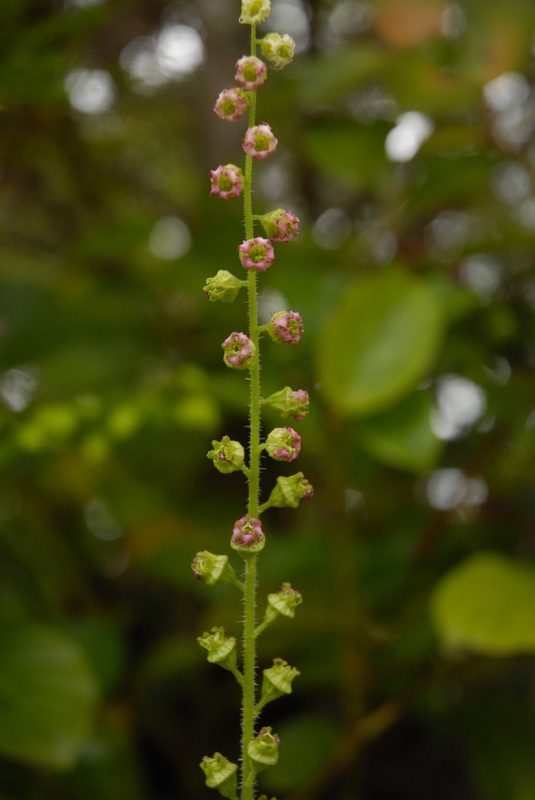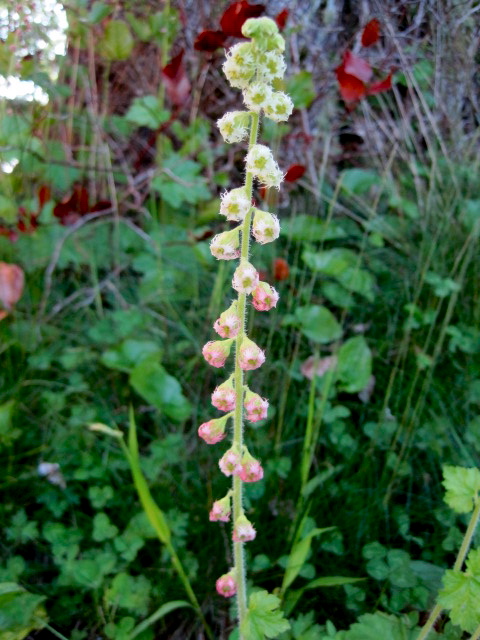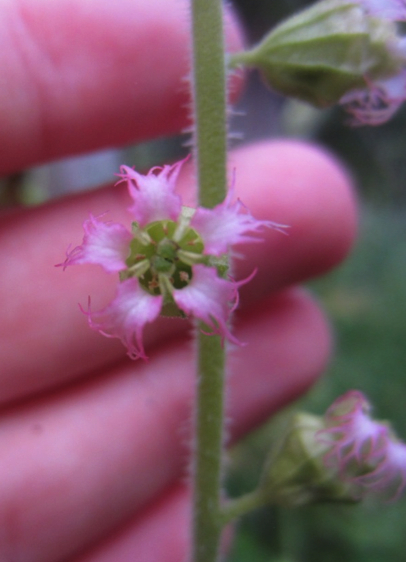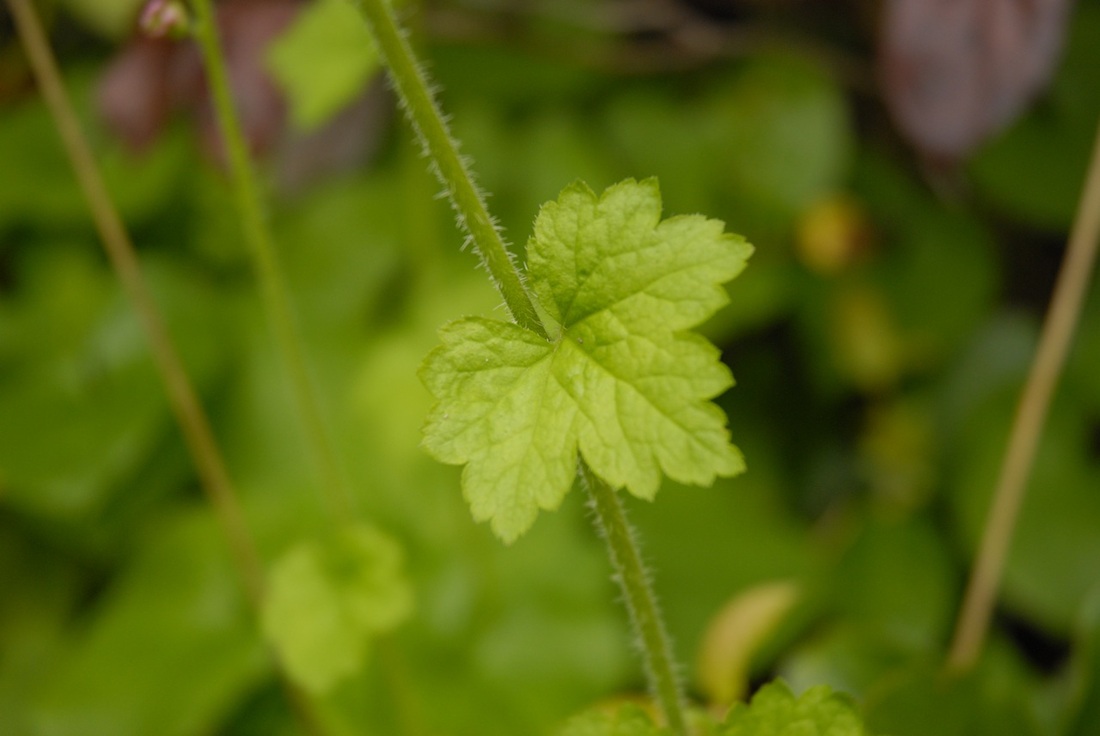Fringecup, bigflower tellima • Tellima grandiflora
{Tellima = anagram of Mitella, another genus of Saxifrage}
Identification
This flowering perennial 40-80 cm tall from short, scaly rhizomes. Stems are very hairy closer to the base. The leaves look somewhat like small maple leaves - they are roughly heart-shaped, have 5-7 shallow lobes, and have jagged, coarsely toothed edges. The basal leaves are larger (5-8 cm wide) and more numerous than the few stem leaves. Many (10-35) small flowers grow from short stalks along the upper portion of the stem. They range from greenish-white to reddish, and darken in colour with age. They are small and shaped like small cups with frilly rims divided into 5-10 lobes.
Habitat & Range
Fringecup grows in moist habitats such as forests, thickets, stream-banks, and avalanche tracks. It is found at low to middle elevations all along the coast and islands from the Aleutian Islands and southern Alaska to California, and east into Alberta, Montana, and Idaho. In western and coastal BC it is more common south of 57º N.
Similar Species
Elmera (Elmera racemosa var. racemosa) is a similar species, but is blue-listed in BC, and is only rarely found in the southwest of the province. It looks similar to fringecup on first glance, but can be differentiated by its kidney-shaped (rather than heart-shaped) leaves. The leaves of coast boykinia (Boykinia elata) can appear very similar to those of fringecup, and the two species can sometimes occur together though the Central Coast is at the north end of coast boykinia's range. The flowers are obviously different, so confusion is only an issue when the plants are not in bloom.
Human Uses
Fringecup was made into a medicinal tea by the Skagit First Nation. This tea was used to treat many illnesses, including loss of appetite.
Intriguing Info
Folklore says that woodland elves ate fringecup to improve their night vision.
iNaturalist
https://www.inaturalist.org/taxa/51655-Tellima-grandiflora
This flowering perennial 40-80 cm tall from short, scaly rhizomes. Stems are very hairy closer to the base. The leaves look somewhat like small maple leaves - they are roughly heart-shaped, have 5-7 shallow lobes, and have jagged, coarsely toothed edges. The basal leaves are larger (5-8 cm wide) and more numerous than the few stem leaves. Many (10-35) small flowers grow from short stalks along the upper portion of the stem. They range from greenish-white to reddish, and darken in colour with age. They are small and shaped like small cups with frilly rims divided into 5-10 lobes.
Habitat & Range
Fringecup grows in moist habitats such as forests, thickets, stream-banks, and avalanche tracks. It is found at low to middle elevations all along the coast and islands from the Aleutian Islands and southern Alaska to California, and east into Alberta, Montana, and Idaho. In western and coastal BC it is more common south of 57º N.
Similar Species
Elmera (Elmera racemosa var. racemosa) is a similar species, but is blue-listed in BC, and is only rarely found in the southwest of the province. It looks similar to fringecup on first glance, but can be differentiated by its kidney-shaped (rather than heart-shaped) leaves. The leaves of coast boykinia (Boykinia elata) can appear very similar to those of fringecup, and the two species can sometimes occur together though the Central Coast is at the north end of coast boykinia's range. The flowers are obviously different, so confusion is only an issue when the plants are not in bloom.
Human Uses
Fringecup was made into a medicinal tea by the Skagit First Nation. This tea was used to treat many illnesses, including loss of appetite.
Intriguing Info
Folklore says that woodland elves ate fringecup to improve their night vision.
iNaturalist
https://www.inaturalist.org/taxa/51655-Tellima-grandiflora
References
Elmera racemosa (S. Watson) Rydb. var. racemosa. In Klinkenberg, Brian. (Ed.). E-Flora BC: Electronic Atlas of the Plants of British Columbia. Lab for Advanced Spatial Analysis, Department of Geography, University of British Columbia, Vancouver. Accessed 15/08/2013.
Pojar, J. and MacKinnon, A. (1994). Plants of Coastal British Columbia. Vancouver, BC: Lone Pine Publishing. P. 167.
Tellima grandiflora (Pursh) Douglas ex Lindl. In Klinkenberg, Brian. (Ed.). E-Flora BC: Electronic Atlas of the Plants of British Columbia. Lab for Advanced Spatial Analysis, Department of Geography, University of British Columbia, Vancouver. Accessed 15/08/2013.
Authors and editors of page
Kelly Fretwell, Ian Cruickshank, and Brian Starzomski (2013).
Elmera racemosa (S. Watson) Rydb. var. racemosa. In Klinkenberg, Brian. (Ed.). E-Flora BC: Electronic Atlas of the Plants of British Columbia. Lab for Advanced Spatial Analysis, Department of Geography, University of British Columbia, Vancouver. Accessed 15/08/2013.
Pojar, J. and MacKinnon, A. (1994). Plants of Coastal British Columbia. Vancouver, BC: Lone Pine Publishing. P. 167.
Tellima grandiflora (Pursh) Douglas ex Lindl. In Klinkenberg, Brian. (Ed.). E-Flora BC: Electronic Atlas of the Plants of British Columbia. Lab for Advanced Spatial Analysis, Department of Geography, University of British Columbia, Vancouver. Accessed 15/08/2013.
Authors and editors of page
Kelly Fretwell, Ian Cruickshank, and Brian Starzomski (2013).








